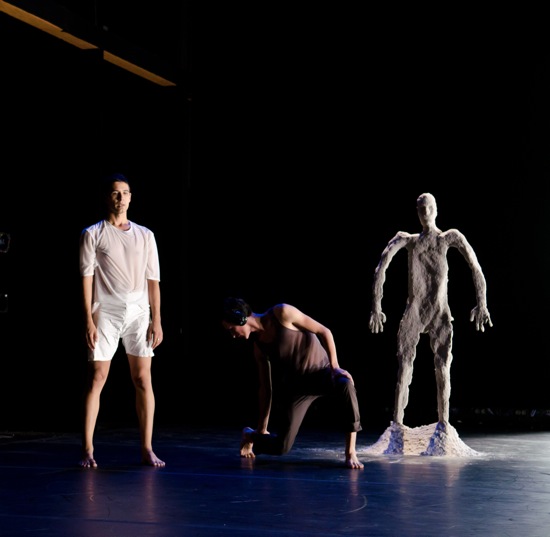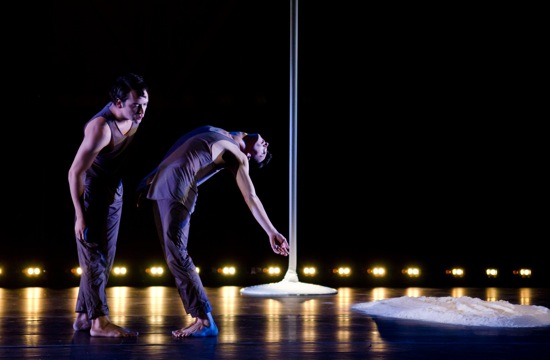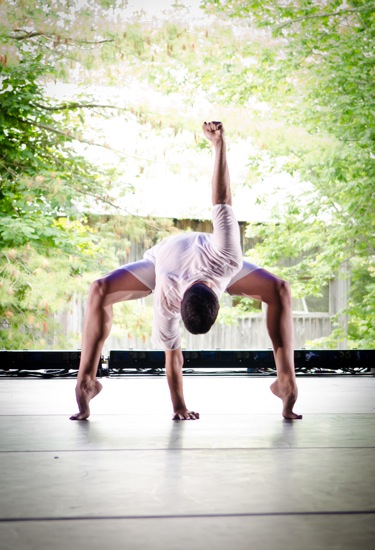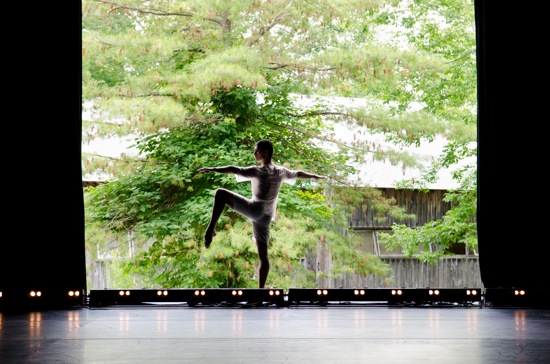The back story: Jonah Bokaer and David Hallberg were working together on a duet—the postmodern dancer-choreographer and the adventurous ballet virtuoso, the dark-haired guy and the blond one. Hallberg broke his foot shortly before the piece was to premiere at the Avignon Festival. Steps were taken. The show went on. Now I’ll shut up and talk about Curtain as it was at Jacob’s Pillow, August 1 through 5.
Bokaer’s brief program note encourages viewers to engage with what’s there before them, rather than what’s not there. This could be an oblique reference to Hallberg, of course, but it also applies in a curious way to the piece as it must first have been conceived by Bokaer in collaboration with artist Daniel Arsham. It’s full of appearances and disappearances, things half-seen in darkness, objects disintegrating, images that vanish or coalesce, sounds we can’t hear, silences, absences. Several times over the course of the evening, Bokaer stretches out his fingers, then lets them curl, but they droop before the hint of claws becomes a reality. How can you not see what you’re not seeing?
The performance is made up of three pieces. Curtain and Les Innocents bookend Sage Phrase, an earlier solo of Bokaer’s, but the first two sections elide, and some of the same motifs crop up throughout. The first image is of Bokaer standing motioness at the rear of the Doris Duke Studio Theater with his back to the audience. The immense barn door is open, setting him against a background of trees in waning sunlight and the partially hidden gray roof of a wooden barn. He’s wearing white shorts and a filmy white shirt (costume: Richard Chai), and rays of light from unseen sources outline his body. In the dark foreground, on opposite sides, James McGinn and Adam H. Weinert rest or sleep while the spectators enter. Chris Garneau’s score has been rumbling quietly for a while now; the soft voice of John Cage, delivering a lecture to Jacob’s Pillow students in 1984 simmers within it.
The music surges into stronger life, and Bokaer breaks his frozen stance by moving his arms away from his sides and bending slightly forward. It’s a pose we will come to know. He’s very deliberate; each move seems thought out, whether he’s executing stiff bends to the sides, opening his arms as if in evocation, or standing on one leg, while making the other sway slowly like a compass needle seeking due north. Half-hidden melodies rise in Garneau’s rich pond of music, as Bokaer rolls into the main area of the space and unfolds his solo.
Two half-made human images, both supine, share the stage with him. It takes a while to realize that Bokaer’s first move echoes theirs (or theirs echo his). The white one stage right has a rough solidity, but he’s barely three-dimensional and later, when Bokaer dismembers it—staring thoughtfully at a forearm, a leg and foot— and the debris is removed, a bluish ghost of the figure lingers on the floor for a few seconds. At almost the same time that this mannequin is unmade, another is created; Weinert carefully pours plaster into the man-shaped hollows of a sand hill stage left. It will solidify overnight into another figure.
Bokaer returns to his opening stance, with the foliage beginning to darken behind him. Suddenly, he’s not there! I must have blinked. Others saw him start to tilt forward so unobtrusively that you almost weren’t sure he was falling until the last moment.
A white substance in addition to the plaster is one of the piece’s mysteries. Is it a liquid? A solid? Both? Between the opener, Curtain, and Bokaer’s earlier solo, Sage Phrase (music by Bernhard Günter), Arsham stands, holding his hands in front of him; long thick streams of the stuff fall slowly from his hands to the floor. When his hands are empty, he bends down to the low mound it has formed, folds it as if it were a piece of cloth, and walks away with it.
Throughout the evening, Bokaer often ponders the stage, the figures, and the audience. Darkness and light are his collaborators too. Not just John Torres’s poetic lighting, but the graying landscape outside the door. At one point in Sage Phrase, Bokaer (who’s now wearing black) is down on the floor, barely visible; when he sits up he blocks the single light on him. Soon after this, he signals for us to be lit, to become manifest to him.
He’s an intriguing dancer and a splendid one, and his sense of rhythmic variety is enlivening. You can seen why Merce Cunningham invited him into his company when he was very young, and you can understand why Bokaer stayed there for a number of years. Like Cunningham, he probes space with articulate legs. Like Cunningham, he’s straight-spined and Apollonian, although without that master’s intermittent wildness. In Curtain, when he allows a tilt to the side to pull him off-balance, or flings one arm around his neck to pull himself into a turn, it’s not as if a strong wind were blowing him; he’s making a test of impetus versus gravity. On the evening I saw Curtain, the final performance of five, the second of the day, he seemed slightly under energy. A moment in Sage Phrase when he slammed to the floor on his belly— one arm stretched in front of him, hand flexed as if to halt someone or something—showed with startling clarity the strength that he prefers to control.

Bokaer, Adam H. Weinert, and a short-lived “presence.” Photo: Liza Voll, courtesy of Jacob’s Pillow Dance
There’s a black curtain at the back, as well as the wide door. McGinn and Weinert sometimes draw or open it. They also lounge at either side of the opening, waiting for something to happen. For the final Les Innocents, McGinn bolts in from the now barely visible landscape like a cat and exits at one side of the stage; Weinert follows. Bokaer, again in white, stands motionless, his back to us, one arm grasping the other behind him. He’s not alone. A crude white figure (perhaps one poured during an earlier performance) stands at one side of the stage.
When McGinn and Weinert reappear, they’re wearing headphones. What are they hearing and from where? Side by side, they move into poses that, like his, recall Greek athletes. I remember that Bokaer, in an interview, spoke of them as shadowing something, but that something isn’t there.

James McGinn (L), Adam H. Weinert, a column falling from above, and a mannequin in the making. Photo: Liza Voll, courtesy of Jacob’s Pillow Dance
Bokaer coolly and systematically destroys the statue, until it’s nothing but an island of rubble for him to the stand on. The two other men improvise a childish game, in which they take turns blowing at each other and responding in turn to the puny wind as if it were a minor gale. In the end, a spill—a curtain, if you like— of the thick white whatever-it-is pours down from above the stage in an increasingly slender column, running out close to when the piece ends.
In the years since Bokaer began to choreograph, he has often collaborated with visual artists and media in unusual ways. In Curtain as a whole, his exploration of process in performance, of disappearances real and illusory announces via the white figures the notion of past, present, and future as simultaneous existences that the dancer coordinates, creates, and destroys.



This made me, of course, wish I’d been there, conveying the mystery and beauty of the pieces extremely well. What can one say about dance and music? Well, exactly this kind of writing/reporting with its passionate attention, openness, generosity.
Did you like it?
Hmm. Did I like it? I thought I made it clear that Bokaer’s piece intrigued me, without spelling the fact out, also that Bokaer’s performance was a little under-energy (unusual for him). However, I accept the comment as a critique that often comes my way: I don’t make strong opinions the centerpiece of a review.